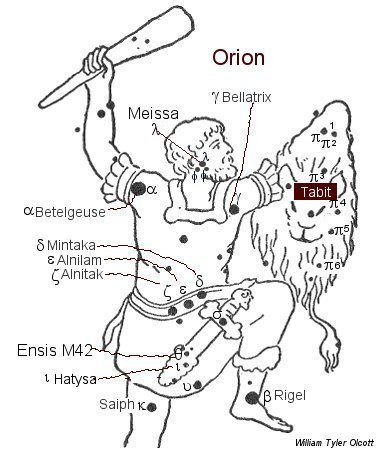| Fixed star: TABIT | |
| Constellation: pi (π) Orion | |
| Longitude 1900: 10GEM31 | Longitude 2000: 11GEM55 |
| Declination 1900: +06.47′ | Declination 2000: +06.57′ |
| Right ascension: 04h 49m | Latitude: -15.23′ |
| Spectral class: F5 | Magnitude: 3.3 |
The history of the star: Tabit
from p.320 of Star Names, Richard Hinckley Allen, 1889.
[A scanned copy can be viewed on this webpage

The other stars are unnamed; omicron, omicron, pi, pi, pi, pi and ; these stars are in a vertical line at the right of the figure of Orion, and indicate the lion’s skin.
Tabit might be from the Arabic Al Thabit “Endurer” [this is also a title for upsilon Orion, a much smaller star that lies on the lower edge of his tunic].
With Pliny these stars in the lion’s skin are supposed to have been a separate constellation known as the Shield, made from the bull’s hide of the Hyriean legend. [The Hyriean legend relates to the story of Zeus, Hermes and Poseidon who were entertained royally by Hyrieus. In gratitude for his hospitality, these gods promised to grant Hyrieus whatever he requested. Hyrieus asked for a son. The three gods then took the hide of a cow or bull, urinated in it (the word Orion is related to “urine” in Greek), and buried it. Nine months later Orion emerged from the ground.]
The stars in the Skin were the Persians’ Al Taj, “the Crown”, or “Tiara”, of their kings; and the Arabians’ Al Kumm, “the Sleeve” of the garment in which they dressed the Giant, the skin being omitted.
Al Sufi’s title was Manica “a sleeve” in heraldry, from a Latin term for a protecting Gauntlet; Mantile and it was figured as a cloth thrown over the Giant’s arm.
Arabic Al Dhawaib, “Anything Pendent” was another name.
Star Names, Their Lore and Meaning, Richard Hinckley Allen, 1889].
The astrological influences of the constellation Orion
Legend: The giant Orion was created out of an ox-hide by the Gods, Jupiter, Neptune and Mercury, at the request of Hyreus who had entertained them. He was blinded by Oenopion (the name means “wine-faced”) for having raped Merope, Oenopion’s daughter, but recovered his sight by exposing his eyes to the rising sun. In consequence of his boast that he could slay any beast bred upon the earth the scorpion (Scorpius) was brought forth and Orion died from its sting. [Robson, p.55.]
Influences: According to Ptolemy the bright stars with the exception of Betelgeuze and Bellatrix are like Jupiter and Saturn. It is said to give a strong and dignified nature, self-confidence, inconstancy, arrogance, violence, impiety, prosperity in trade and particularly by voyages or abroad, but danger of treachery and poison. It was thought by the Romans to be very harmful to cattle and productive of storms. By the Kabalists it is associated with the Hebrew letter Aleph and the 1st Tarot Trump “The Juggler.” [Robson, p.55.]
The astrological influences of the constellation Orion given by Manilius:
“Near neighbor to the Twins (Gemini), Orion may be seen stretching his arms over a vast expanse of sky and rising to the stars with no less huge a stride. A single light marks each of his shining shoulders, and three aslant trace the downward line of his sword: but three mark Orion’s head, which is imbedded in high heaven with his countenance remote. It is Orion who leads the constellations as they speed over the full circuit of heaven.” [Astronomica, Manilius, 1st century AD. p.35.]
Orion will fashion alert minds and agile bodies, souls prompt to respond to duty’s call, and hearts which press on with unflagging energy in spite of every trial. A son of Orion’s will be worth a multitude and will seem to dwell in every quarter of the city; flying from door to door with the one word of morning greeting, he will enjoy the friendship of all.” [Astronomica, Manilius, 1st century AD. p.305.]
References:
Fixed Stars and Constellations in Astrology, Vivian E. Robson, 1923].